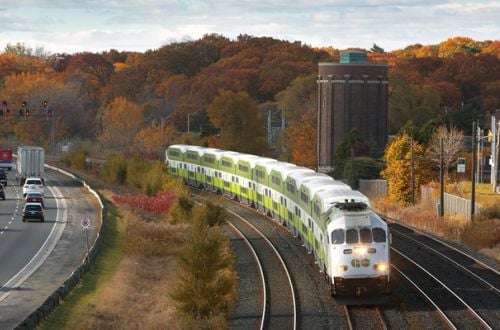In June 2017, Ontario’s minister of transportation Mr Steve del Duca announced that Metrolinx would study the feasibility of adopting HFC power on the Go network as an alternative to electrification using conventional overhead catenary.
The study by CH2M Hill Canada, Ernst & Young, and Canadian Nuclear Laboratories considered both the train service pattern and rail vehicle fleet mix to analyse the technical and financial requirements for operation of the Hydrail System.
The study concludes that implementing Hydrail across the Go network would be complex, and a world-first for a large-scale commuter rail system.
The report identifies two significant challenges for such a project. Firstly, designing and building a fleet of HFC trains for the proposed high-density RER services carries a risk of delay due to the complexity of integrating the fuel cell system into the rail vehicle platform. Secondly, the system would require around 1% of the electricity generated daily in the province of Ontario and would therefore be vulnerable to fluctuations in energy prices. This economic viability of Hydrail would be heavily dependent on how electricity price variability risk is apportioned with the private sector.
The study stresses the need to develop Hydrail as a complete end-to-end system, with the trains at one extremity and the power grid at the other.
The report notes that conventional electrification also carries significant project risks, but Hydrail could offer broader benefits to the province in terms of economic development in the technology sector. It could also act as a catalyst for the adoption of hydrogen in other areas of society.
One option in the current RER proposals envisages using electric locomotives operating in push-pull mode with 12 double-deck coaches. The Hydrail study recommends using two smaller HFC locomotives because the volume of hydrogen on a single locomotive would be insufficient to meet range requirements between refuelling cycles.
This could give Metrolinx the option of splitting the train into two consists of one locomotive and six coaches, enabling the operation of shorter trains at off-peak times and thereby reducing operating costs. It would also enable Metrolinx to continue to operate its existing fleet of double-deck coaches.
An assessment of the Net Present Value (NPV) cost of implementing and operating the Hydrail System suggests a benefit: cost ratio (BCR) of 3.01 can be achieve with a low-cost scenario and 2.65 for a high-cost scenario. The BCR for the existing RER business case is 3.07 based on conventional electrification. The overall lifecycle of Hydrail system is deemed to be similar to that of standard overhead electrification.
Metrolinx plans to tender the RER project using a Design-Build-Finance-Operate-Maintain (DBFOM) model. Metrolinx says this would allow a single entity to manage all interrelated decisions and oversee each phase of the project from design to maintenance, optimising implementation and system performance.
The study recommends that Metrolinx should continue developing concepts for both a HFC locomotive and multiple unit, begin developing designs for hydrogen refuelling facilities and production systems, and work with regulators to clarify safety rules. It also suggests the development of framework for bid proposals to be used as part of the DBFOM process, and cooperation with the province to develop a cross-government business case for Hydrogen.

